Anti-submarine seaplane "Sin Maive" PS-1 (Japan)
In 1953, the company “Sin Maive”, on its own initiative, began to work out the project of a promising multipurpose seaplane. It should be noted that she really could cope with such work. Until 1949, the company was called Kawanishi Kokuki, and had previously gained fame as a manufacturer of fighter jets and flying boats. In the postwar period, she was engaged in the production of various components and assemblies for various equipment and was mainly a subcontractor. Now, the specialists of the company could use the previously accumulated experience and modern technologies to create a promising aircraft.
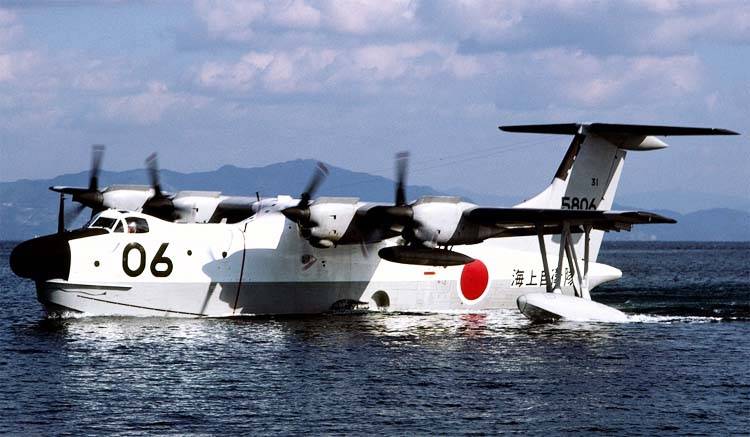
PS-1 serial aircraft on the water
By 1958, the designers of the Xing Maive, headed by Shizuo Kukihara, completed a preliminary study of the appearance of future equipment, and also completed part of the required design work. The finished project was planned to submit to the command of the Self-Defense Forces, as a result of which an order for mass production of equipment could appear.
By the end of the fifties, the command of the Japanese Self-Defense Forces came to the conclusion that it was possible to purchase a number of hydroplanes suitable for solving some combat and auxiliary tasks. Soon an agreement appeared on the purchase of six American-made Grumman SA-16 Albatross aircraft. With the help of this technique, renamed UF-1, the Japanese planned to strengthen the existing fleet, as well as to study the features of the use of flying boats in modern conditions. In addition, it was decided to support the domestic manufacturer and order the development of its own project. First of all, the military wanted to get anti-submarine aircraft.
The project of the “Xin Maive” company was notable for a certain complexity and suggested using a number of original solutions. The flying boat was to receive a hull of a new configuration that improves seaworthiness, an automatic control system and controls the boundary layer. All these ideas and solutions required preliminary testing in practice, which required a new flying laboratory. Its construction began in 1960.
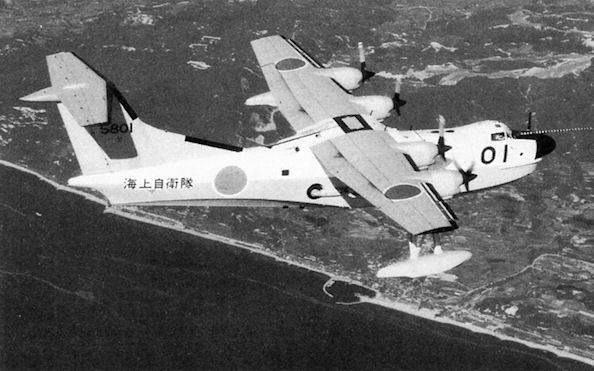
The first prototype PX-S in flight
Another SA-16 aircraft was acquired in the USA especially for the construction of a flying laboratory under the working name UF-XS. It was soon rebuilt in a noticeable way. So, the configuration of the hull-boat has changed: it was equipped with an additional step and a new tail section. In addition, the aircraft received two additional 1340 hp Pratt & Whitney R-600 engines. They were located in new wing gondolas, outside of the two standard engines. An additional engine was also used, with the help of which the boundary layer blowing system from the flaps and rudders functioned.
At the end of December, the 1962, the flying laboratory of the UF-XS, first flew into the air. The trials lasted several months; There were many take-offs and landings from and to the water. It was found that the new controls show themselves well in the work, and the modified configuration of the hull-boat provides an increase in the basic characteristics. Even before the testing of the flying laboratory was completed, the design of a full-fledged multipurpose machine began. This sample of equipment received the designation PS-1. The brand name SS-2 was also used.
The project PS-1 proposed the construction of an all-metal cantilever high-profile with a sealed fuselage-boat. To protect against waves and splashes, the plumage was built in a T-shaped pattern. The plane could move overland with a retractable landing gear, but the design and strength of the latter did not allow to take off and land. On the water it was proposed to use the hull-boat of the same design with the zygomatic flaps of a new form and a pair of floats under the wing. The power plant consisted of four main and one additional engine.
The PS-1 aircraft fuselage was distinguished by an increased section, which was due to the need to lift the wing and the engine above water. In front of the fuselage were the crew cabin and instrument compartment. Most of the internal compartments were given to the placement of special equipment, its operators and weapons. The composition of the internal equipment was determined in accordance with the modification and purpose of the aircraft.
A wing with a straight center section and trapezoidal consoles was developed. The power set of the wing was built on the basis of two spars. On the leading edge were slats, on the rear - flaps and ailerons. Also located on the upper surface of the wing ailerons. On the center section and in the root parts of the consoles were placed engine nacelles of four engines. Near the wing tips under the wing were installed two floats, which improved the stability on the water.
The T-shaped tail of the aircraft received an arrow-shaped keel with a developed gargrot and a trapezoid-shaped stabilizer in terms of shape. The plumage was completed with a standard set of deflected planes. On the keel there was a rudder, on the stabilizer - elevators.
Two-section flaps and elevators on the stabilizer have a boundary layer blowing system. The compressed gas was supplied via internal pipelines from a compressor driven by an auxiliary power unit. The PS-1 project provided for the installation of a separate General Electric T58 gas turbine engine with an HP 1360 power. Blowing the boundary layer allowed to optimize the flow of the rudders, as a result of which their efficiency was increased. The main consequence of this was an improvement in controllability in all modes, including low-speed flight.
Four turboprop engines General Electric T64-IHI-10 with the power of 3000 hp were used as the main power plant. each. The engines set in motion three-bladed adjustable Hamilton Standard 63E-1 screws with a diameter of 4,42 m. Due to the great height of the fuselage and the high-wing wing, the propeller blades always remained above the water surface. Contact with the waves was excluded.
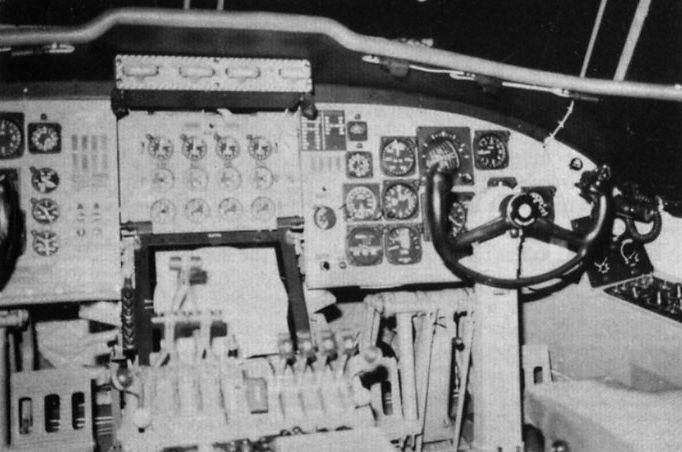
Aircraft dashboard
The plane was supposed to use mainly water aerodromes, but at the same time it could use land platforms. In particular, a triple-support retractable chassis was provided for launching a slip. Three racks with a pair of wheels on each were removed in the fuselage.
The X-Maive PS-1 flying boat was developed as a multipurpose aircraft, and therefore the composition of the on-board equipment, crew size, etc. should have been dependent on the specific modification. However, in all cases, the crew included two pilots, a navigator and a flight engineer. There were always several types of communications equipment on board. The steering control system was built using an irreversible power steering.
For the carriage of cargo or passengers, a large cabin was intended, occupying the entire central and tail part of the fuselage. Access to the cabin was provided through the door in the tail section of the left side. A large loading ramp of the type of "land" aircraft was not envisaged.
According to the project, the PS-1 aircraft was supposed to have a length of slightly less than 33,5 m and a wingspan of 33,15 m. Parking height - 9,95 m. . The estimated maximum flight speed reached 23,3 km / h. Range - more than 36 km. The ceiling was limited to 510 km. The hull ensured takeoff and landing at waves up to 3800 m and winds up to 7,2 knots.
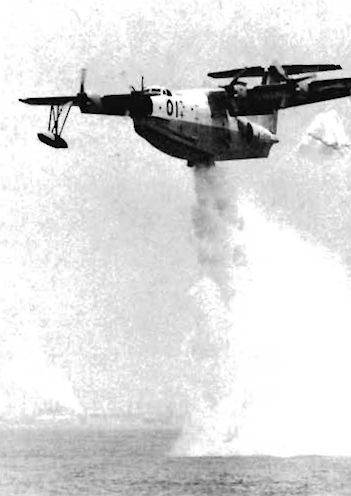
Prototype PX-S in firefighter configuration
In April, 1965, the company "Sin Maeve" began construction of the first prototype PS-1. This machine has received its own designation PX-S. Building a flying boat took just over two years. The developer has made the bulk of the required components independently. Two types of engines were purchased from Ishikawjima-Harim, which produced them under a US license. In the middle of 1967, the first prototype came out of the assembly hall. By this time, the second machine was in full swing.
The first flight of the PX-S took place on October 5 1967 of the year. A few months later, at the beginning of 1968, a second prototype was attracted to the tests (according to some data, this car was defined as the first pre-production one). After several months of testing, two prototypes showed their potential. In addition, some design flaws were identified and eliminated. After that, two prototypes were sent to the 51 th test squadron (Iwakuni base) for military tests. According to the results of all inspections, the aircraft was recommended for adoption.
According to the decision of the military, the anti-submarine modification of the flying boat was to go into the series. This project included equipping the aircraft with radar AN / APS-80J, AQS-10A magnetometer, HQS-101 hydroacoustic station, means for working with sonar buoys, etc. In addition to the four pilots, the crew of the anti-PS-1 consisted of two observers, two operators, a tactical coordinator and a radio operator. The equipment and the crew were placed in the cargo compartment: the equipment and workplaces were located along the starboard, rest areas and the kitchen - at the left.
In the tail section of the cabin, a compartment was provided for the transport of radio-acoustic buoys. It placed up to 20-like devices, as well as the means of their discharge into the water. Between the engine nacelles on the wings installed two pylons for anti-submarine weapons. Destroy the found targets with the help of four depth bombs weighing 150 kg or using Mk 44 or Mk 73 torpedoes. Next to the wingtips were launch guides for six 127-mm unguided rockets of the Zuni family.
In the mid and late sixties, the Xing Maive company built two pre-production aircraft. In 1969, the first serial PS-1 equipped with an anti-submarine complex rose into the air. Over the next few years, Japanese naval aviation received two lots of such equipment. A total of 23 flying boats, including prototypes, were built. The pre-production and serial vehicles were transferred to the 31 th anti-submarine squadron, which served on the basis of Iwakuni.
Even before the launch of serial production, the National Fire Fighting Agency became interested in the PS-1 project. By his order was created a new modification of the aircraft. In 1976, the PX-S prototype was equipped with water tanks, bucket suction devices and nozzles for discharging liquid. While traveling on water, the plane could get more than 8 tons of water and then dump them on fire. In the same 1976, the prototype passed all the necessary tests, but the project was in a difficult situation. Order was not followed, and in the early eighties from this version of the aircraft refused.
Even at the stage of military tests, it became clear that the PS-1 “Xin Maive” airplanes show good performance, and therefore are of great interest to the Naval Self-Defense Forces. In this regard, it was decided to order the development of unified machines for other purposes. First of all, naval aviation required a transport and search and rescue vehicle. Also the company-developer could create a new version of the fire plane and a passenger sample.
The result of the development of the original project PS-1 was a new aircraft called US-1. The first such car was lifted into the air in the 1974 year, and a few years later an order for mass production appeared. Flying boats with high performance and ample opportunities have found their place in the structure of naval aviation.
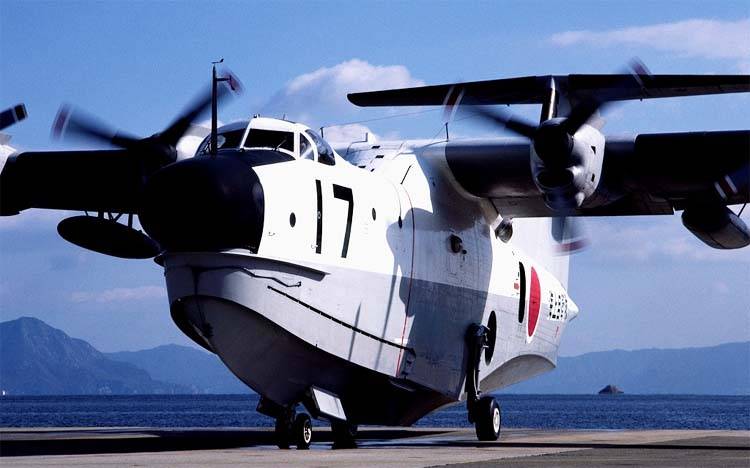
The PS-1 could go ashore, but taking off from the land lanes was excluded
Operation of the basic anti-submarine aircraft PS-1 continued until the end of the eighties. Naval aviation received 20 such machines. During the service under certain circumstances, six aircraft were lost. All others continued service until the end of the eighties, when it was decided to replace such equipment.
Despite the relatively small age, the PS-1 flying boats in the late eighties ceased to fully organize the Japanese military. The detection of modern submarines of the likely enemy was no longer guaranteed, and therefore the command was forced to take action. In the 1989 year, the Japanese Self-Defense Forces decided to remove the anti-PS-1 from service. Instead, the search and detection of submarines now had to be solved by other aircraft. After reviewing the available proposals, the Japanese military department chose the American Lockheed P-3 Orion vehicles.
Soon obsolete equipment was written off. Several flying boats were handed over to the museums, and the rest went for recycling. It should be noted that the rejection of anti-PS-1 did not affect the further service of the US-1 aircraft. For some time they remained in the ranks and continued to solve transportation problems or assist the victims. Later they were replaced, but this time it was about replacing domestic technology with equipment.
The Xin Maive company, the former Kawanishi Kokuki, had a lot of experience in building flying boats and also knew how to use modern technology. All this made it possible to develop a fairly successful project of an anti-submarine aircraft capable of taking off and landing on water. In addition, this model of technology could become the basis for several new aircraft of a different purpose and in fact turned into the base for the whole family.
On the materials of the sites:
http://airwar.ru/
http://aviadejavu.ru/
https://militaryfactory.com/
https://airspacemag.com/
http://airvectors.net/
http://nvo.ng.ru/
- Ryabov Kirill
- Aviadejavu.ru, Airwar.ru
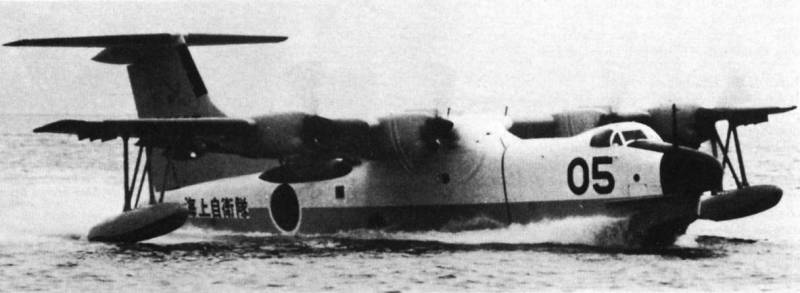
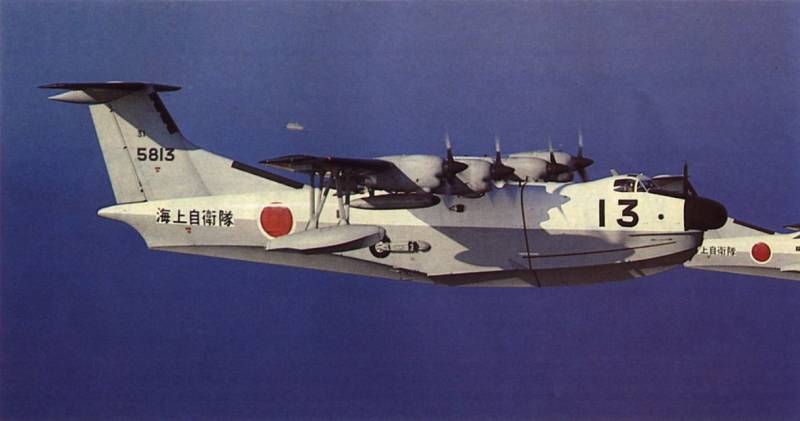
Information